How to Avoid Keyword Cannibalisation and Boost Your Organic Search Performance

At first glance the topic of cannibalism sounds pretty grim.
Whether we’re talking about humans eating other humans, or your web pages failing to maximise their organic search performance, it’s not pleasant to think about.
But with a greater understanding of what keyword cannibalisation is, and more importantly how to resolve and avoid it, the subject matter won’t seem so gruesome.
In this post, we’ll explain:
- What keyword cannibalisation is
- What causes keyword cannibalisation
- How to avoid and resolve keyword cannibalisation
What is keyword cannibalisation?
Keyword cannibalisation is when one page on a site eats into the SEO performance of another. This occurs when multiple pages on the same domain cover similar themes or topics or target the same keywords.
As these pages are essentially vying against themselves as well as competitors in the search results, neither achieves the highest ranking it could. As a result, organic traffic and revenue are not maximised.
This can be particularly challenging when the page you want to rank for a keyword is being outranked by another. When this happens, search engines have essentially decided that the less desirable page is better-suited to addressing the user’s query – even if you don’t agree.
What causes keyword cannibalisation?
There are several schools of thought from SEOs about cannibalisation, including what causes it, what constitutes it, and whether intent should be part of the nomenclature when addressing it.
While the so-called thought-leaders slug it out with debates over semantics, we’ll boil it down to the most common causes:
Multiple URLs hosting similar content
Content cannibalisation is a particular challenge for ecommerce sites selling products with minor variations, or who have to balance site structures and information architecture (IA) between UX and SEO. There’s often a huge overlap between the two, but they don’t always entirely align.
To illustrate this point, ecommerce sites often need to cater for multiple user journeys for different target audiences which can lead to internal cannibalisation.
For example, Salon Services – a leading supplier to the hair and beauty industry – have different sections of their site dedicated to hair, beauty, and nail professionals as well as barbers. Each section of the site has a subsection dedicated to salon furniture.
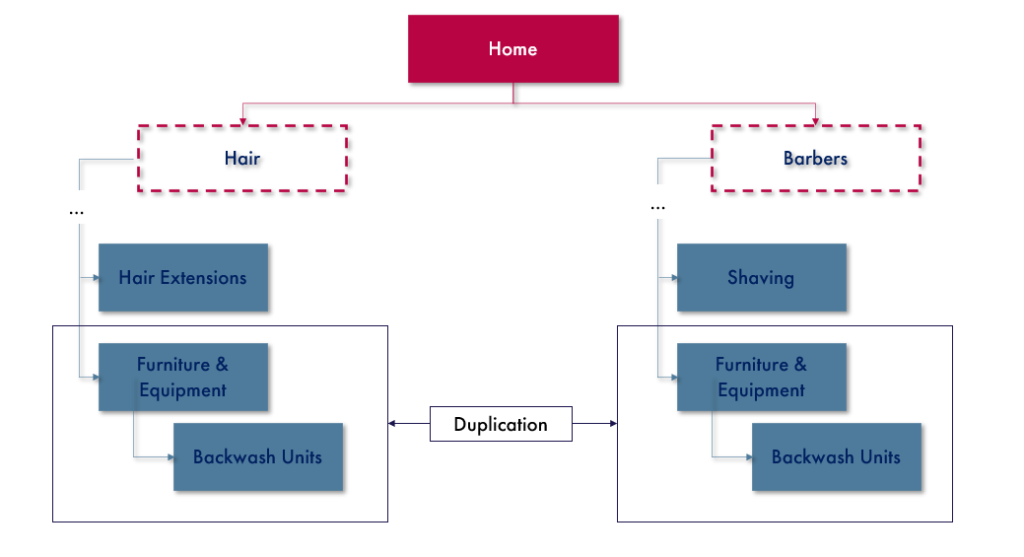
From a user journey perspective, this allows each of those customer groups to easily find furniture for their businesses within the site section most relevant to them.
Naturally, many of the products that are on each of those different pages are very similar.
So, when there isn’t a huge degree of variance in the way different customer groups search for those products, you can see how those pages end up competing for a similar group of semantically themed keywords.
Ineffective keyword targeting and optimisation
At its most basic, keyword cannibalisation is when multiple pages, such as blog posts and product category pages, target the same high-volume keywords.
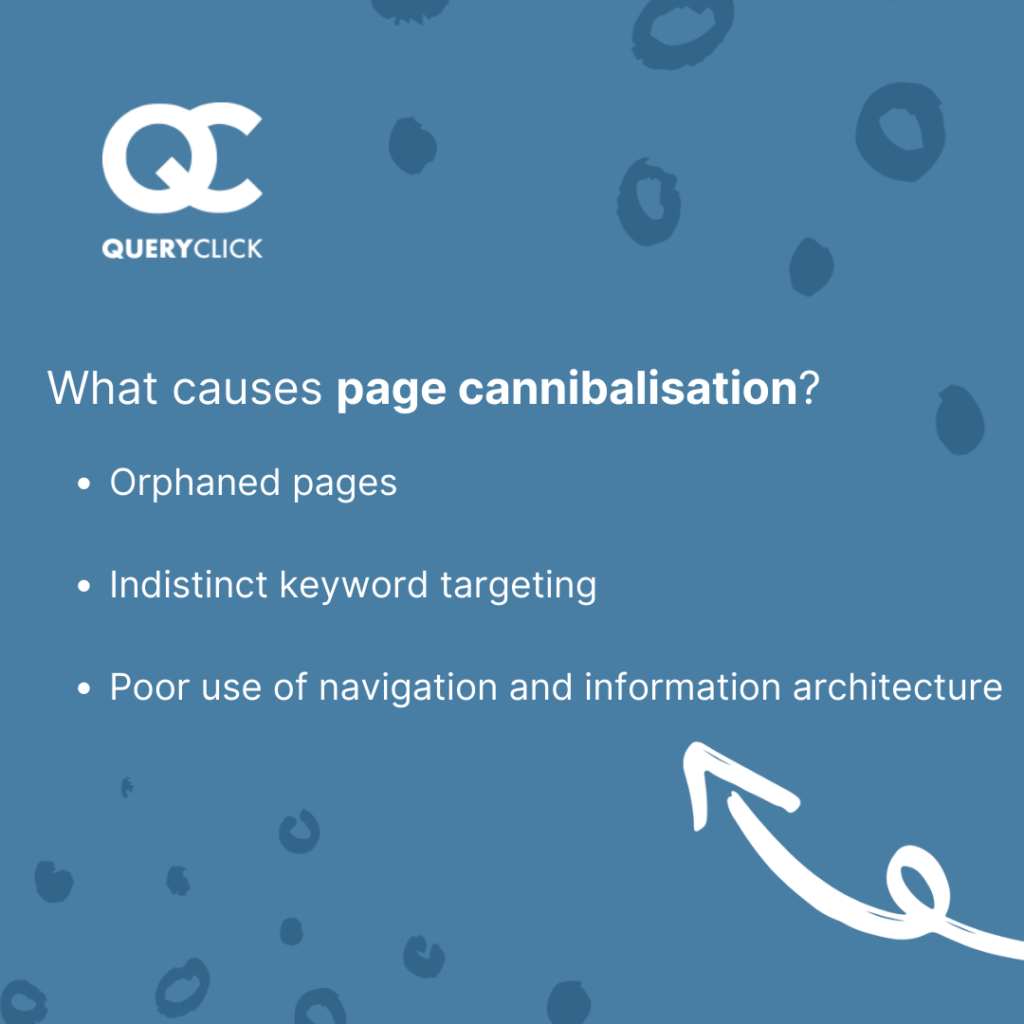
For example, luxury cashmere manufacturers Johnstons of Elgin may create a blog post that details the impressive craftsmanship that goes into their tartan scarves, including details on their heritage having operated mills in Scotland for over two centuries.
This is a perfectly valid approach given the history of the brand. However, if they chose to target the keyword ‘tartan scarves’ with that blog post, they may find it competes with their tartan scarves product category page.
We may expect a degree of competition between the two pages despite the fact they exist to serve different purposes.
This is perhaps the starkest example of the intent cannibalisation debated amongst SEOs.
There are other elements of imperfectly executed optimisation that can give confused signals to search engines about page importance and purpose. These include:
- Orphaned pages – An orphaned page is a page that isn’t linked to from anywhere on the site. This suggests to search engines that the page is not important, and makes it difficult for their crawlers to find. As a result, you can expect a different and potentially less desirable page to rank for the keywords you’d like your orphaned page to rank for. Failure to include a page in your XML sitemap can also contribute to this.
- Indistinct targeting – Indistinct targeting is when you target the same keywords on different pages of a site – i.e. across different product category pages. It can also happen when multiple pages have the same or similar intent.
- For example, if QUIZ Clothing were to optimise both their nightwear and loungewear pages for the keyword ‘comfy clothes’, both of those pages would compete for that keyword. This would be compounded if the keyword wasn’t just included in the content on the page, but was also used in anchor text in internal links to the pages.
- Poor use of navigation and IA – Similar to orphaned pages, not linking to key pages from your main navigation can result in search engines devaluing their importance. Equally, placing a page in the wrong subfolder on your site can create confusion about its relevance and whether it’s the best page for search engines to serve to a user.
- Hypothetically, if trade plumbing specialists Wolseley were to host their underfloor heating page in their radiators subfolder, rather than in the heating section, there’d be a problem. You may see the main heating page ranking better (albeit in a poor position and not as well as a properly placed underfloor heating page) for queries related to underfloor heating.
Content gaps
Content gaps are arguably a wider problem but can still lead to internal competition between pages and sub-optimal ranking performance.
To illustrate this point, let’s imagine footwear and clothes retailer, schuh, start to sell a new brand of women’s hi-top trainers. For the sake of argument, let’s call them ‘Brand Y’ (yeah, we’re not a branding agency).
If they just created product pages for the trainers, but no broader ‘Brand Y’ gallery page, then they would have no clear page to target broader ’Brand Y’ searches.
Therefore, we’d expect the product pages as well as other category pages that feature those products (i.e. women’s trainers and women’s hi-top trainers pages) to compete for ‘Brand Y’ related searches. They’d also likely fail to attain strong rankings for top-level searches like ‘Brand Y Trainers’ or ‘Women’s Brand Y Shoes’.
As we mentioned, it’s not nice to see your website and marketing efforts performing sub-optimally.
So let’s move away to the altogether happier topic of making it better.
How to resolve cannibalisation
The first step in addressing keyword cannibalisation is to identify the issue.
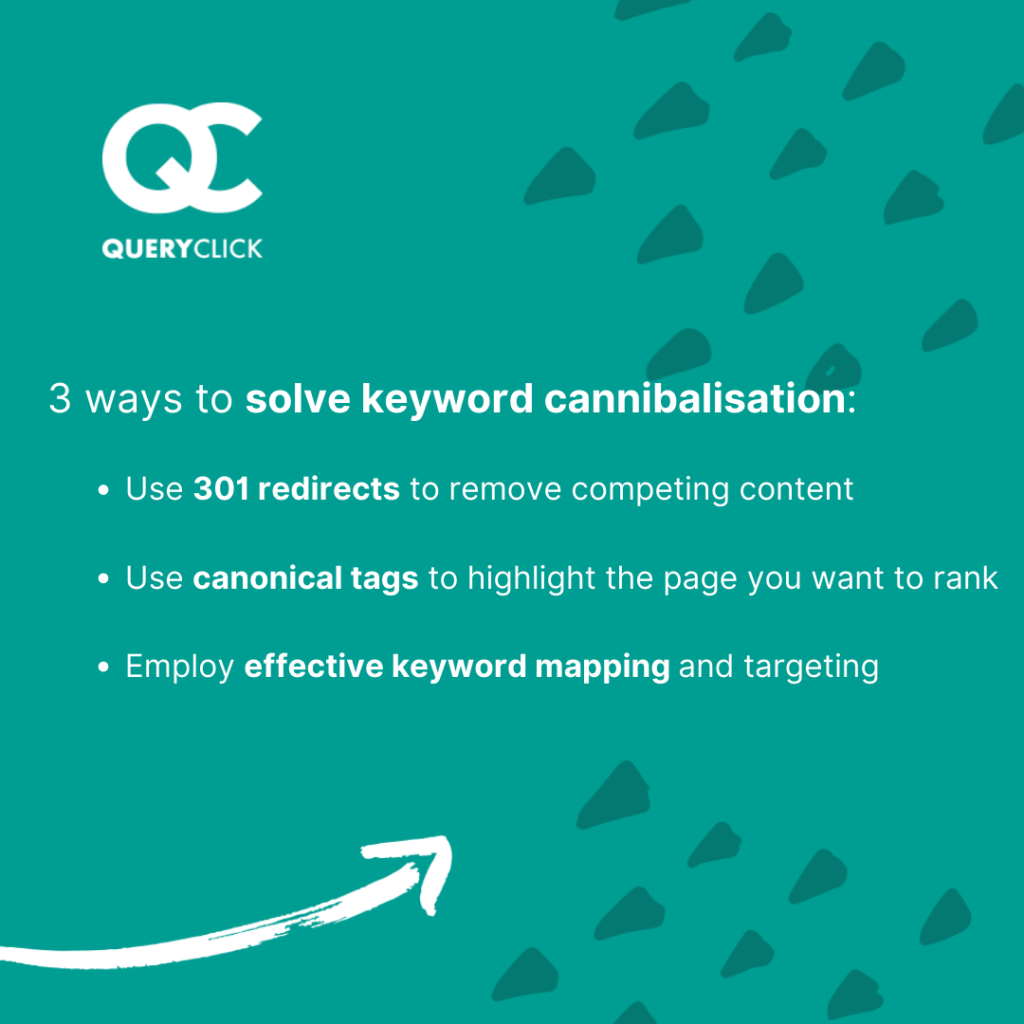
If you’re fortunate enough to have access to specialist SEO tools, like Ahrefs, they’ll each have detailed guidance on how to identify the issue using their software. The same can be said for rank tracking software like STAT, which has a multiple ranking URLs report that can help you identify cannibalisation.
If you don’t have access to these, you can use Google Search Console’s Performance Report. This enables you to see the queries you’re ranking for and the page(s) that are ranking for each of those queries (note – this can be a bit fiddly to do at scale).
Google Data Studio can be used in conjunction with Search Console to see this on a larger scale. Although, your best bet is to seek help from SEO specialists (like us!).
Is Poor SEO Performance Eating Away At Your ROI? Contact Us For Improved Results!
Having identified your cannibalisation issues, there are several possible fixes you can deploy. Each keyword cannibalisation fix has its own advantages and conditions where it’s most appropriate, which we’ve broken down below:
1. Use 301 redirects to remove competing content
If you’ve spotted two or more pieces of competing content you can consolidate them by implementing a 301 redirect on the pages you don’t want to keep, pointing to the page you do want to keep.
A 301 redirect signals to Google that a page has permanently moved to the target URL, and most ranking and backlink authority is transferred to the new page.
You should also update any internal links that point to the removed page to now point to the consolidated one.
This is to ensure users aren’t taken through any unnecessary redirects to reach the content they want (which can have a negative impact on page speed).
When is it best to use 301 redirects to tackle cannibalisation?
The page you’re removing no longer serves a purpose, or another page serves it as effectively.
For example, a vinyl record shop could have a gallery page for Neil Young records, and another for his albums released under the name ‘Neil Young and The Stray Gators’.
Here, the ‘Neil Young and the Stray Gators’ page could be redirected to the main Neil Young page, helping to avoid cannibalisation between the two for Neil Young related searches.
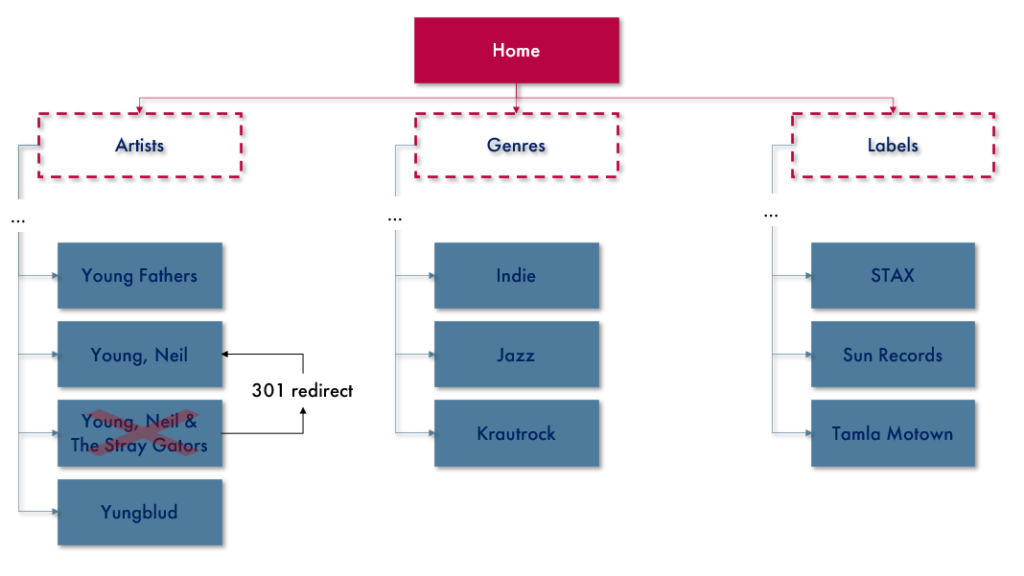
This not only helps with cannibalisation – it will also help with crawl efficiency too.
2. Use canonical tags
Canonical tags are used to tell search engines that a specific URL represents the ‘master copy’ of a page and are a useful tool for preventing cannibalisation caused by duplicate content.
If you have two or more pages with similar or duplicate content, you tell search engines what URL you’d like to rank in search results by adding a canonical tag to the competing pages that point to the master page.
By using a canonical tag in the html of a page you’re effectively saying to search engines; “Yeah, we know these pages are pretty much duplicates, but we need to keep them both and this is the URL we want to rank.”
To find out more, check out Google’s handy advice on canonical pages.
When should you use canonical tags?
There’s a valid reason for having very similar or duplicate pages on your site, and they both provide the same value to users.
This is a common challenge for ecommerce platforms, so canonicals are a handy solution – thanks search engines!
We can use Salon Services again to highlight a handy use for canonical tags.
Both the ‘Barbers’ and ‘Hair’ sections of their website have pages for backwash units that feature exactly the same products.
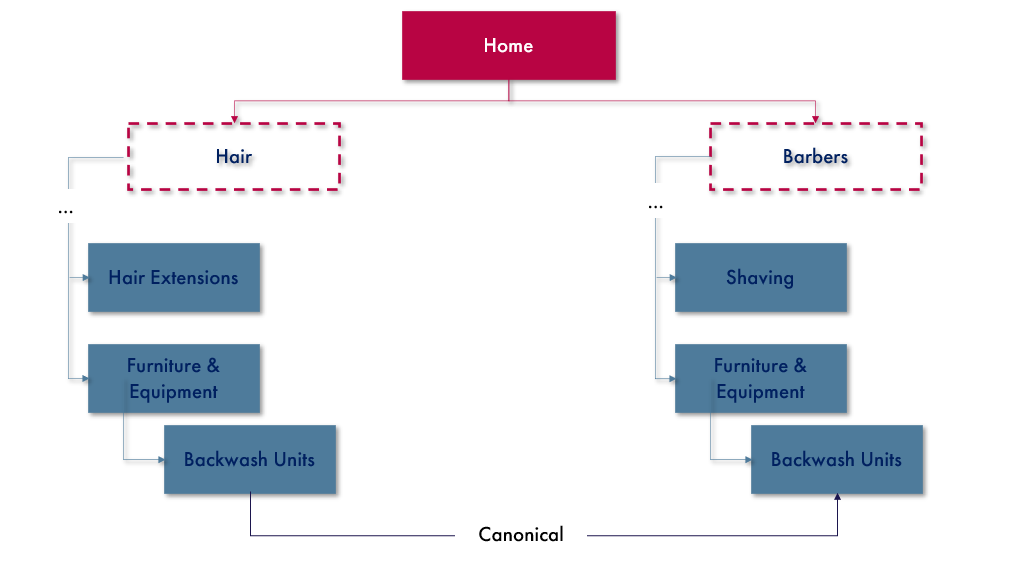
A quick look at performance stats shows that the Barbers version of the page is performing best out of the two, making it the ‘master’ page (or the page we want to rank in search results).
To prevent that page’s performance from being cannibalised by the identical ‘Hair’ section page, a canonical tag is added to the Hair page pointing to the master Barbers page.
Now Google knows that the backwash unit page in the Barbers section of the site is the only URL that should rank for related search terms.
3. Effective keyword mapping and targeting
Keyword mapping is the cornerstone of your SEO strategy, so something may have gone awry if it’s leading to cannibalisation. We’re not ones to cast blame. It can happen!
The solution here is to take another look at your keyword mapping, ensuring every page on your site targets unique keywords on-page as much as possible.
When should you use keyword remapping and optimisation?
The pages that are cannibalising each another serve different purposes and intents, but the desired page to rank for a keyword is being outperformed by another.
When this happens, it’s necessarily to follow an SEO 101 approach with a couple of tweaks:
Keyword mapping:
- Ensure each page has a closely related, unique group of target keywords mapped to it.
- Check and double check you’re using the most suitable page on your site to target those keywords.
- The keywords targeted should be those most directly relevant to the content of each page.
- The purpose of the page is aligned with the intent behind the keywords. For example, your blog content targets the type of keywords people use when they want information, and your transactional content targets the type of keywords people use when they want to buy a product.
Content optimisation:
- Each page uses a unique page title, meta description, headers, and page copy.
- These elements have the target keywords naturally woven through, and the content is very specifically focused on those keywords.
- Internal anchor text for linking to pages on your site is consistent and distinct. You should always use the unique target keyword(s) for the page you are linking to as the anchor text.
- If you cannot avoid using a keyword on a page that is mapped to another, and it’s causing cannibalisation issues, turn it into the anchor text for a link to the page you want to rank for that keyword.
That final point is vital. You can even purposely add cross linking between two competing pages to send another signal to users and search engines about their differences. Just ensure that you use the unique target keyword of the page you are linking to.
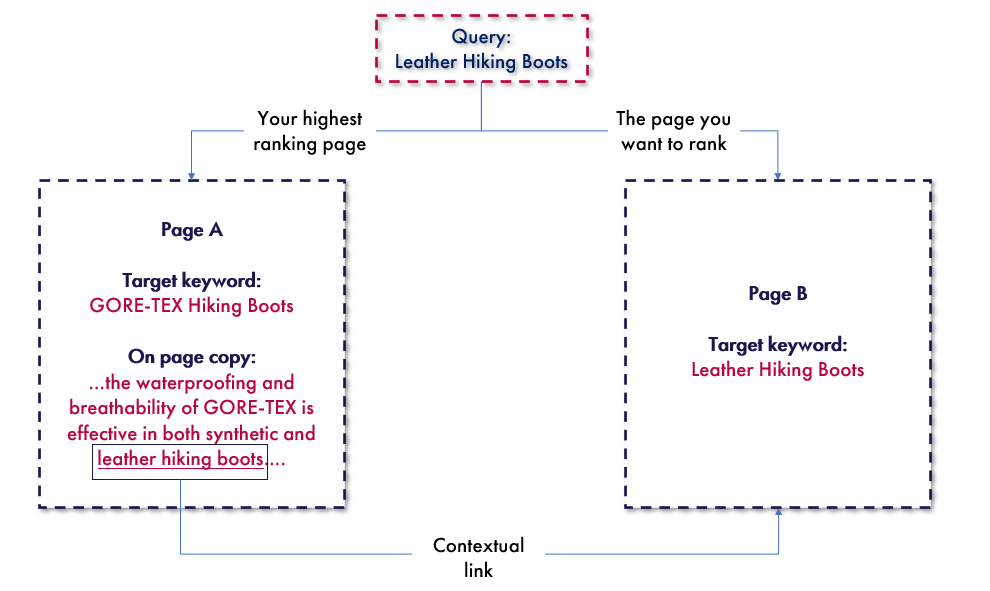
In conclusion…
Keyword cannibalisation is a common challenge in SEO, and it’s something the vast majority of ecommerce sites will have to address. In fact, cannibalisation can go beyond SEO. You may find that if your SEO and PPC strategies aren’t working together effectively, they can cause similar issues across channels.
Luckily the solutions are much less daunting than being faced with literal cannibalism! There are several actions you can take to avoid it, which may require collaboration from different departments.
These solutions include:
- Effectively removing competing content
- Correctly implementing canonical tags
- Ensuring you’re adhering to SEO best-practice with keyword mapping and optimisation
If you’re interested in getting help with your cannibalisation issues, why not get in touch and find out what our team of SEO specialists can do for you?
While you’re here, check out our SEO blog and knowledge base for more great insight on how to maximise your ROI and get the most from your digital marketing.
Own your marketing data & simplify your tech stack.
Have you read?
Generative AI is transforming the way that marketers plan and assemble content for their Paid Ads. As big platforms like Google, Meta and TikTok increasingly build the tools needed to...
In a surprising move that has sparked heated debate, Mark Zuckerberg announced on his Instagram that Meta will be reducing its levels of censorship and in particular fact-checking on its...
It is no understatement to say that the impact of AI in marketing is huge right now. Here we take a look at some of the top uses cases that...



